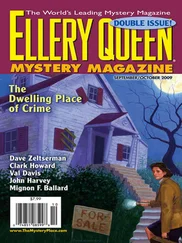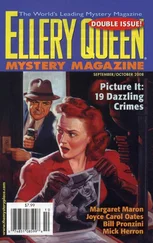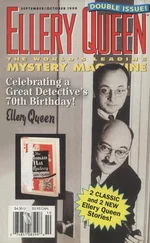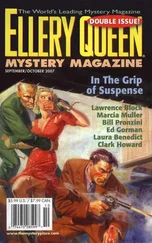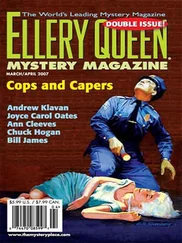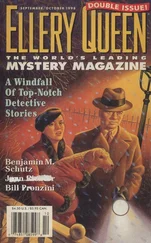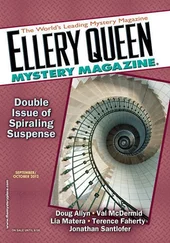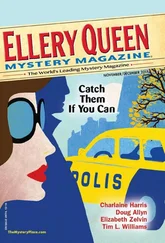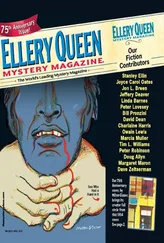Тимоти Уилльямз - Ellery Queen’s Mystery Magazine. Vol. 126, No. 3 & 4. Whole No. 769 & 770, September/October 2005
Здесь есть возможность читать онлайн «Тимоти Уилльямз - Ellery Queen’s Mystery Magazine. Vol. 126, No. 3 & 4. Whole No. 769 & 770, September/October 2005» весь текст электронной книги совершенно бесплатно (целиком полную версию без сокращений). В некоторых случаях можно слушать аудио, скачать через торрент в формате fb2 и присутствует краткое содержание. Город: New York, Год выпуска: 2005, Издательство: Dell Magazines, Жанр: Детектив, на английском языке. Описание произведения, (предисловие) а так же отзывы посетителей доступны на портале библиотеки ЛибКат.
- Название:Ellery Queen’s Mystery Magazine. Vol. 126, No. 3 & 4. Whole No. 769 & 770, September/October 2005
- Автор:
- Издательство:Dell Magazines
- Жанр:
- Год:2005
- Город:New York
- ISBN:нет данных
- Рейтинг книги:4 / 5. Голосов: 1
-
Избранное:Добавить в избранное
- Отзывы:
-
Ваша оценка:
- 80
- 1
- 2
- 3
- 4
- 5
Ellery Queen’s Mystery Magazine. Vol. 126, No. 3 & 4. Whole No. 769 & 770, September/October 2005: краткое содержание, описание и аннотация
Предлагаем к чтению аннотацию, описание, краткое содержание или предисловие (зависит от того, что написал сам автор книги «Ellery Queen’s Mystery Magazine. Vol. 126, No. 3 & 4. Whole No. 769 & 770, September/October 2005»). Если вы не нашли необходимую информацию о книге — напишите в комментариях, мы постараемся отыскать её.
Ellery Queen’s Mystery Magazine. Vol. 126, No. 3 & 4. Whole No. 769 & 770, September/October 2005 — читать онлайн бесплатно полную книгу (весь текст) целиком
Ниже представлен текст книги, разбитый по страницам. Система сохранения места последней прочитанной страницы, позволяет с удобством читать онлайн бесплатно книгу «Ellery Queen’s Mystery Magazine. Vol. 126, No. 3 & 4. Whole No. 769 & 770, September/October 2005», без необходимости каждый раз заново искать на чём Вы остановились. Поставьте закладку, и сможете в любой момент перейти на страницу, на которой закончили чтение.
Интервал:
Закладка:
The downtown stretch of the Interstate passed through a veritable canyon formed by vertical concrete walls varying in height from ten to twenty-five feet. For the past three weeks, the two westbound lanes closest to the grassed median had been shut down for repairs. One of the lost lanes had been regained by diverting slow-lane traffic onto the right shoulder.
A semitrailer truck now stood immobile, its cab in the shoulder lane less than a yard from the concrete retaining wall and its fifty-three-foot trailer slued across the lane next to it, reducing the flow of traffic at that point to a single lane. Patrolman Johnny Myers was struggling valiantly to keep the traffic moving through the one clear lane.
The afternoon heat radiated from the pavement and the retaining wall in waves, and the air was poisonous with the exhaust of an endless stream of idling cars and geared-down trucks. Beyond a straggling colonnade of orange plastic barrels, workers in hard hats sweated in the closed lanes, and pieces of heavy equipment maneuvered awkwardly around each other in the narrow median. The earsplitting chatter of jackhammers, the hiss of compressed air, and the growl of bulldozers reverberated from the concrete surfaces, forming a background to the unceasing chirp of Myers’s whistle. Dollinger parked his cruiser on the shoulder, head-to-head with Myers’s cruiser.
In imminent peril from motorists gunning up to speed after passing the narrow point, Auburn and the others got out and squeezed in single file between the truck cab and the wall.
Nick Stamaty, the investigator from the coroner’s office, was squatting next to a body in the narrow wedge-shaped space between the truck trailer and the wall. Ten yards further along the wall, a motorcycle lay on its side. Beyond that they could see an ambulance with lights flashing. Patrolman Bystrom, who had been with Myers in the cruiser when they responded to the call, was talking to the ambulance crew. Although their services were obviously not needed, the crew were more or less trapped at the scene because Stamaty’s van had their ambulance blocked.
The bed of the trailer was so high that passengers in the cars snaking by could look under it and see Roger Mulreedy’s battered remains. He hadn’t been wearing a helmet, but it wouldn’t have made much difference if he had. Evidently he and his cycle had been bounced or raked along the retaining wall by the right front fender of the semi. Parts of him looked like illustrations in an anatomy atlas.
Stamaty acknowledged the arrival of the investigators from Public Safety with a genial nod, as if they’d just casually met on the steps of the courthouse. “Look but don’t touch, guys,” he said. “This red stuff you see all around here isn’t transmission fluid.”
In a rubber-gloved hand he held up the driver’s license he’d found on the body. The photograph matched the face, more or less. Kestrel had already put down his field kit and unstrapped his camera.
“Where’s the truckdriver?” Auburn asked Stamaty.
“Up in his cab, lying across the seat. Bystrom has his license.”
“Let’s see these bullet holes.”
“They’re not holes, Cy, and they may not have been made by bullets. But in the circumstances... Come on over and take a look.”
The motorcycle was a lightweight Japanese sport model. Although few of its aluminum and fiberglass parts now retained the shape they’d had when they left the factory, the low-slung, wraparound windscreen had escaped shattering. Stamaty didn’t need to point out the four starred pockmarks in the high-impact plastic. As Auburn crouched on the gritty pavement to get a better view, he sensed Kestrel’s hand hovering in the direction of his right arm, ready to intervene immediately should he so far forget himself as to touch the cycle before it had been duly photographed.
“Must have been pretty low-velocity projectiles,” said Auburn. “Maybe from a BB gun. Whatever they were, they were four of a kind. Each of these marks looks exactly like the other three. Otherwise I’d say maybe it was some chips kicked up by a jackhammer, or gravel flying off something traveling in front of him. No bullet wounds on him?”
“Hard to be sure, the shape he’s in. I couldn’t find any holes in his shirt or his pants. And I didn’t see anything that looked like bullet marks anywhere else on the cycle.”
Somewhere a clock was striking five.
Patrolman Fritz Dollinger hauled his ponderous frame erect after examining the motorcycle. “Those marks don’t look all that fresh to me,” he said. “Could have been there a long time. Could be the outer edge of a shotgun burst.”
Bystrom had joined the group. “The trucker said the biker lost control suddenly and flipped over, and he couldn’t stop in time to keep from hitting him.”
“If somebody did shoot him out of the saddle,” remarked Stamaty, “they could have been up there on the Sixth Street overpass. Maybe some crazy kid with a slingshot or a wrist rocket.”
“Pretty fast reloading for a slingshot,” said Kestrel, who had seldom been known to agree with Stamaty about anything.
“It could have been a pellet gun,” said Bystrom. “Maybe somebody that didn’t like bikers — or anyway this particular biker.”
“Let’s not impanel the jury till we talk to the truckdriver,” said Auburn. “He was here when it happened, and we weren’t.”
Stamaty had photographed the scene before they arrived, but they had to wait while Kestrel took pictures of the motorcycle (seemingly from most of the thirty-two compass points) before they unlocked its cargo compartment with the key on Mulreedy’s ring. A careful search turned up no alcohol, drugs, or firearms. They did find tools, a mostly empty lunchbox, and papers pertaining to the heating and cooling business that Mulreedy worked for.
Auburn strongly doubted that the marks on the windshield had anything to do with Mulreedy’s death. At this point he thought it likely the truck driver would be charged with vehicular homicide. He got the keys to the cruiser from Dollinger, locked the contents of the cycle’s cargo compartment and a plastic bag containing the articles from the victim’s pockets in the trunk, and came back with forms on a clipboard.
Before approaching the truckdriver, he walked back between the wall and the trailer to get more information from Bystrom. Myers’s whistle still shrieked with unflagging vigor as he waved the traffic past the narrow spot, first blending two lanes into one. The thudding of a traffic helicopter hovering directly overhead was now added to the symphony of noise surrounding the scene.
Bystrom and Myers had arrived less than five minutes after Hoopes, the truckdriver, had radioed a report of the accident to the State Highway Patrol on Channel 9. Because of the location within the city limits, the Highway Patrol dispatcher had routed the call to Public Safety, and the cruiser had been just three blocks from the scene. The ambulance crew from the downtown Fire and Rescue station had arrived within a minute after them. They had found Mulreedy obviously beyond help and Hoopes in a state of mild hysteria.
“Did you walk him?”
“Are you kidding? In this circus?” Bystrom’s father was a retired fire captain, and he’d known Cyrus Auburn since he was eight.
“Somebody better do it.”
“He’s all yours. Here’s his license. And the accident report.”
Dollinger had just finished helping Stamaty tuck a blue plastic tarpaulin over Mulreedy’s body. “Fritz,” Auburn told him, nodding toward the closed lanes and the median, “somebody over there has to have seen something. And those guys are going to be knocking off work about now. Get with their foreman and talk to as many of them as you can.”
Читать дальшеИнтервал:
Закладка:
Похожие книги на «Ellery Queen’s Mystery Magazine. Vol. 126, No. 3 & 4. Whole No. 769 & 770, September/October 2005»
Представляем Вашему вниманию похожие книги на «Ellery Queen’s Mystery Magazine. Vol. 126, No. 3 & 4. Whole No. 769 & 770, September/October 2005» списком для выбора. Мы отобрали схожую по названию и смыслу литературу в надежде предоставить читателям больше вариантов отыскать новые, интересные, ещё непрочитанные произведения.
Обсуждение, отзывы о книге «Ellery Queen’s Mystery Magazine. Vol. 126, No. 3 & 4. Whole No. 769 & 770, September/October 2005» и просто собственные мнения читателей. Оставьте ваши комментарии, напишите, что Вы думаете о произведении, его смысле или главных героях. Укажите что конкретно понравилось, а что нет, и почему Вы так считаете.

